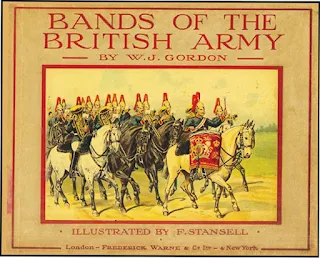With this blog author’s sincere
apologies and major correction, as published in “Tradition” the plates were not
given attribution. Superficially observing the style, and obviously without
more careful examination, I attributed the paintings to Simpkin, in error.
There were however other talented military artists working in the same time
frame.
One, though not as obviously
recognized as Simpkin, was a contemporary named F. (Frederick) Stansell (not further
identified), and all of these plates should be attributed to him, not Simpkin.
They were published in a book entitled Banks
of the British Army, authored by W.J. Gordon, in London in 1914. Suffices to say the book
is now extremely valuable.
This significant error was diplomatically brought to this author’s attention by a blog reader named “moonshadow” and is gratefully acknowledged. Thank you very much. The peculiar thing is the blog article was published in 2012, and the error has not been picked up until now, February 2018. I guess this just serves to show how esoteric the subject matter of the blog really is.
One interesting historical note can be observed in Plate IV. The kettle-drummer of the 2nd Dragoons (Royal Scots Greys) is wearing a black bearskin. The painting apparently having been done prior to the presentation, and/or authorization for wear, of the white bearskin to the regiment by its then Colonel-in-Chief, Czar Nicolas II of Russia (1894-1916). As is normally the case, double click on any of the plates to enlarge.
 |
| Major Frederick Joseph Ricketts Bandmaster, Plymouth Division, Royal Marines 1930 - 1944 (pen name Kenneth J. Alford) |
The following is a video of the renowned march music of Kenneth J. Alford. Composing marches under that pen name, Maj Frederick Joseph Ricketts, RM, ranks in Great Britain and the Commonwealth, as well as the rest of the world, as certainly equal to John Phillip Sousa. His most famous march is "Colonel Bogey". Born in 1881, and joining the British Army as a Band Boy in 1895, he rose through the ranks to eventually serve as the Bandmaster of the 2nd Bn Argyll and Sutherland Highlanders. After a long and complicated process, in 1930 he was appointed Bandmaster of the Band of the Plymouth Division, Royal Marines (Principal Band of the Royal Marines). There he rose to the rank of Major, before his retirement in 1944, a span of time encompassing five monarchs and three major wars. Like Richard Simkin, given his life long service and truly remarkable musical contribution, he was not even awarded the Order of the British Empire. This is particularly galling in light of the OBE having been awarded in more recent times to certainly much less talented or deserving modern "musicians". Those who might be interested in more details, as well as a list of his most famous marches, are referred to the following on YouTube; https://www.youtube.com/watch?v=dWxF_lp7UNs


.jpg)
.jpg)
.jpg)

.jpg)
.jpg)
.jpg)




3 comments:
Are you sure these are R.Simkin's works. I've seen the exact same paintings as single figure plates attributed to F.Stansell as illustrations to the book “Bands of the British Army” by W. J. Gordon, published in London 1914.
Hello moonshadow,
Sincere thanks for your correction, and taking the time to bring it to my attention. As you and other readers will observe, my major error in attribution has been corrected in the blog article.
Best regards,
Jim
Hello! Thanks for this article, I love to see the prints. It is perhaps understandable to get the artist mixed up here. Stansell was a contemporary and was definitely in touch with Richard Simkin. I know that he indeed worked with him (and also artist Harry Payne) on the production of a sheet of drum banners for the printers Gale and Polden.
Frederick Stansell from Bath was a wallpaper designer by trade who painted military subjects on the side. He also continued the bands and drum banners theme by painting the John Player cigarette card set "Drum Banners and Cap Badges" - still cheap and easy to find on eBay.
Thanks again.
Post a Comment